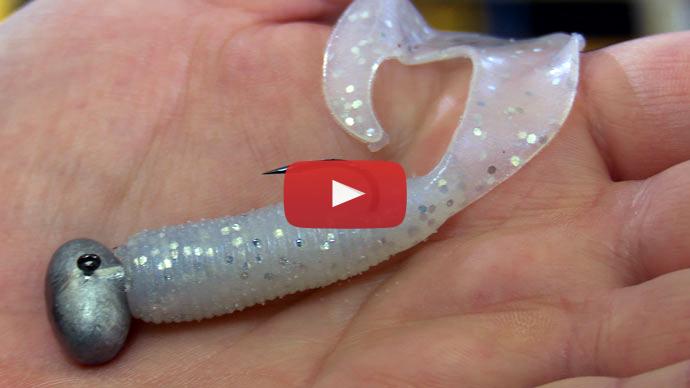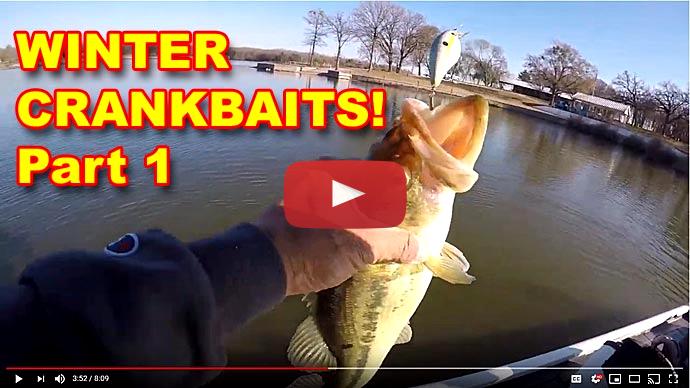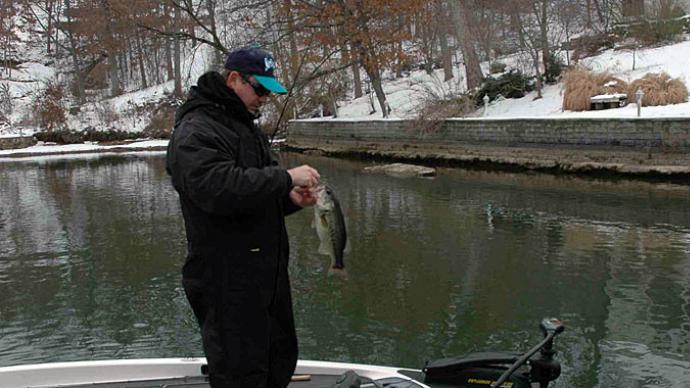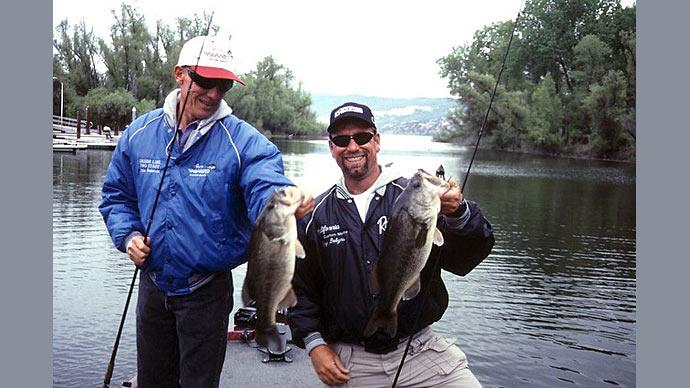Hey, folks. Glenn May here with BassResource.com. Today I want to talk about seven winter bass fishing tips that can help you catch more bass this wintertime. You know, it's funny I do get people that ask me, "Hey, can you catch fish during the winter?" Absolutely. You sure can. There's a misconception that the bass just kind of hibernate, hang out, don't really eat much, and it's hard to catch them. They're really lethargic and slow and all these other things I hear about. And the reality is, bass are cold blooded creatures and the water temperature is what dictates their metabolism. Meaning, they'll eat a lot more and their metabolism, they'll churn through those calories a lot faster when the water is warm versus when it's cold. So in the summertime, they may eat seven times a day, whereas in the wintertime, they might eat once every seven days. So the bite is going to be a lot slower. Imagine if your lake that you love to fish in had 75% less fish all of the sudden. You're presenting your lure to less fish that are more apt to bite your lure because there's less fish that are in the feeding mode in the wintertime. So just have that mindset going in. It's going to take a little bit more work to get bites. But it can be worthwhile because this time of the year is when the bass are real fat, they're big, they're almost at the biggest they're going to be all year round. So when you do catch a fish, it's going to be a good one.
So let's get into the seven tips. Starting out with number one, bait choice. Bait choice is actually easier during the wintertime because as a general rule, the bass aren't aggressively hitting topwater baits and fast moving lures. So that kind of eliminates topwater, spinnerbaits, crankbaits, those type of things. And instead, you're looking for bottom hugging baits or baits that stay near the bottom, or baits that represent dying baitfish. Because this time of year, the baitfish and the forage the bass are feeding on are far more affected by the cold temperatures than the bass. And actually as it gets colder down into the mid-40s and lower, these fish are struggling to stay alive. You know, especially if you have like threadfin shad, that sort of thing, they're dying off. So lures that imitate that action can really pay off for you in the wintertime.
So for example, using metal baits, blade baits and spoons are really good baits to use because they mimic dying fish, that action, the falling, fluttering, dart and diving action that baitfish look like when they're dying. It triggers that instinctual behavior in bass and you can get bit that way.
Using jigs crawled on the bottom, they look like slow moving gobies or slow moving sculpin or even crawdads that are moving along in the bottom. You know, they're not going to hop and jump and bounce around. Sculpin for example, don't have air bladders. So they can't jump. So keep it on the bottom, crawl it nice and slow to mimic the prey that the bass are keying on.
Another type of baits to use are jerkbaits. Deep diving suspended jerkbaits can be really productive this time of year, those that get down to 10 feet or more and just sit there and suspend. It's a great bait to use. You don't pull on it as hard as you normally do during the warmer months. So it's more subtle jerks, don't move the bait as far, and the pauses are a lot longer, three to five minutes. I mean, long, long pauses, barely move it. This is why it needs suspending because you don't want it to float back up to the top. Sometimes what I'll do is I'll take like some golfer's tape or something like that or take some solder wire, wrap it around the hook shanks to give it a little bit more weight, not a ton, but just enough to make it slowly barely sink. Because again, there's long pauses in between so you don't need it to fall rapidly. But that'll give it that kind of dying fish action again, and you give it those little twitches and it looks just like a dying baitfish. So those jerkbaits can be really, really productive.
And then finally, I like to use finesse tactics using drop shot and split shot rigs. I'll throw things like three-inch tubes, maybe three-inch minnow type baits, or four-inch finesse worms, those hand poured finesse worms on these rigs. And again, crawl on them nice and slow on the bottom, trying to imitate those baitfish or this forage that's moving real slow can really trigger a lot of bites. So that's number one, lures.
The second tip I can give you, like I mentioned earlier, is moving it really slow, if you haven't got a theme yet. It's because the baitfish are really lethargic. And the forage is really lethargic. And so they're moving slow. It's not because the bass are lethargic and that they can't chase down a fast-moving bait. They can and will. They're still able to do that. But it will look out of place if you're moving a bait really fast because all the forage that the bass are keying on right now are struggling to stay alive at times. And so they're moving slow, they're moving lethargic, and they're moving irradically. So you want to mimic that behavior. That's what they're really triggering on right now. So if you just move your bait really fast across the water, well, it looks out of place. So slow down your bait movement, focus on those slow, methodical moves. You really have to focus hard on that bite because it's gonna be real subtle, but that's the key to catch them during the wintertime.
Tip number three, if you're fishing current, fishing rivers, that sort of thing, look for eddies, look for little shallow areas that are off the main current area, the main river, places where the water can get stagnant for, you know, lack of a better word. Those are areas that will warm up. If you get a quick little warming trend, it gets sunny out, those areas will warm up and the bass will go in there because baitfish, again, they're trying to survive the winter. So just a couple degrees difference is all they need. You know, so they'll move up in those areas, little back pockets out of the current to help survive the winter and those bass will follow right in. So look for those areas, those little back pockets and back current areas. Those things can be really productive for rivers.
The next tip, for lakes, you want to look as a general rule, deeper water. You want to find areas that for example, if you knew an area that was really productive during the pre-spawn on this lake last spring, back up a little bit, go a little bit deeper near there and start there looking for fish. You want to start...I usually look around 15, 20 feet and go all the way down to 55 feet deep. And you're looking for structure, you're looking for long lake points, humps, ridges. Deeper water typically is more stable during the wintertime so the water temperatures don't fluctuate as much and it's a little bit warmer, because that surface temperature changes more rapidly as it gets colder during the wintertime. So those deeper temperatures are where the baitfish are going to be, and that's where the bass hang out chasing them.
Tip number five, use your electronics to find those deep water areas. You have to understand what you're seeing on your depth finder to be able to find these great areas that can hold a lot of fish, and to find the baitfish. Typically, what I like to do is find balls of baitfish and figure out what depth they're hanging out at and look at the structure, look at the map of the lake and find those points, those ridges, those humps that intersect at that depth level. That's where I'll begin fishing. And the depth finder is really important in locating those areas. It's more than just finding out how deep it is, it's looking at, are you looking at boulders versus chunk rock versus gravel? Can you find something that's hanging out on that point? Say if it's a stump, or maybe big boulders on the point. Those type of things is where the bass are going to be holding. You're not looking specifically for bass, but baitfish and then the structure and hopefully something on that structure that's going to locate them. Understanding what you're seeing and interpreting your graph is going to be super important during the wintertime and to help you succeed better.
The next tip, number six, dress for success. I can't emphasize enough the need to wear warm clothing. I dress in layers. I have, you know, thermals on, and then I have a layer of clothing over that, and then I have a nice warm jacket over that, it's a wind-proof, rain-proof jacket. If you don't have rain-proof jacket, then make sure you got your rain gear nearby, both your bibs and your jacket in case the weather turns bad.
You don't have to fall in the water to have effects of hypothermia. Cold weather, especially wet cold weather, you can get hypothermia during the wintertime, trust me. Been there, done that, I have a t-shirt, don't want another one. It's not fun. Dressing warmly is critical to your success. Not only is it safer in the wintertime but also, being comfortable, being dry, will enable you to focus more on fishing and what you need to do and concentrate. If you're uncomfortable and cold, you're not gonna be able to focus as much on fishing. So dress for success.
And finally, tip number seven is be patient and keep your focus. As I mentioned earlier, in the wintertime, the bass, there's just not as many that are biting. So the bites are going to be few and far between. So understand that going in, it's not going to be fast and furious like you would have normally during the summertime. There are exceptions. I have caught bass on New Year's Day on buzzbaits. But that doesn't happen very often in the wintertime. For the most part, it's slow fishing. So know that going in, be patient. And the other thing you need to do is absolutely maintain your focus.
This is difficult to do when the bite is really slow. You've gone an hour or so and you haven't had a bite and your buddy wants to talk or you listen to the radio or you're looking at the shoreline and what's going on, whatever it is, you're distracted. Those bites because you're moving so slow with your baits, they're very subtle. The bass don't have to run down and annihilate and hit and attack your bait. So the bites aren't going to be real strong bites. For the most part, they're going to be real subtle. I've seen it where I've had my bait in 35 feet of water and the rod tip just moves, you know, a 16th of an inch, not even an 8th. You can't even see my finger moving, I bet. It barely moves. And I'm looking at that rod tip going, "You know, I didn't do that." So either I just pulled across a weed or a rock or something as the boat moved a little bit or maybe something on the other end bit it. And there's been times I've just set the hook just to see what's there and it's a fish. The bite is that subtle. If you're not focused and paying attention all the time, you're going to miss that. And you could miss out on the trophy of a lifetime because a lot of these fish are really big this time of year.
So pay close attention, be patient and follow these seven different tips I just gave you, and it's going to up your chances of catching some really nice fish this winter. Good luck. And for more tips and tricks like this, visit BassResource.com.






